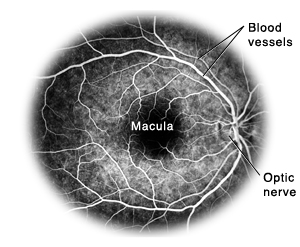A
B
C
D
E
F
G
H
I
J
K
L
M
N
O
P
Q
R
S
T
U
V
W
X
Y
Z
Click a letter to see a list of conditions beginning with that letter.
Click 'Topic Index' to return to the index for the current topic.
Click 'Library Index' to return to the listing of all topics.
Fluorescein Angiography
Fluorescein angiography is an eye test. It looks at the back of your eye, including:
-
The blood vessels in your eye
-
The layer of tissue at the back of your eye (the retina)
-
The center of your retina (the macula)
-
The optic nerve
This test can diagnose diseases found in these areas. To do this test, a dye called fluorescein is injected into your arm. The dye goes into your bloodstream and up into the blood vessels in your eyes. A special camera is then used to take images (angiograms) of your eyes.
 |
| A fluorescein angiogram of the retina. |
Getting ready for your test
Before anything is done, you will be asked to read and sign a form giving your consent for the procedure. Read the form carefully. Have all your questions answered before you sign it.
Tell your healthcare provider if you:
-
Are pregnant or think you may be pregnant
-
Are breastfeeding
-
Have a history of severe allergic reactions, including to X-ray dye or other medicines
-
Have kidney problems
Tell your provider about any recent health problems and any medicines you are taking. You may need to stop taking all or some of these before the test. This includes:
-
All prescription medicines
-
Over-the-counter medicines such as aspirin or ibuprofen
-
Illegal drugs
-
Herbs, vitamins, and other supplements
You should arrange for an adult family member or friend to drive you home after your test. Your vision will be blurry for up to 12 hours.
Follow any other instructions from your healthcare provider.
During your test
Here is what to expect:
-
You are given eye drops to enlarge (dilate) your pupils.
-
You then sit in front of a special camera. You place your chin on the chin rest and look into the camera.
-
Images are taken of your eyes, one eye at a time.
-
Fluorescein dye is then injected into your arm. The lights in the room are turned off. You may have mild nausea. You may have a warm feeling in your arm or upper body. Tell your healthcare provider if your skin feels itchy or if you are having trouble breathing. If so, you could be having an allergic reaction to the dye.
-
More pictures of your eyes are taken over about 15 minutes. The camera shines a bright light into your eyes. Try to keep your head still and your eyes open.
-
When enough images have been taken, the test is over.
After your test
Your vision will be blurry for up to 4 to 12 hours. This is because of your dilated pupils. Your eyes will be more sensitive to light for up to 12 hours. You may want to wear sunglasses during this time. Don't drive if your vision is very blurry. You may also find it hard to read. Your skin may look yellow for a few hours. This is from the dye. Your urine will be dark yellow or orange for 24 to 48 hours.
Risks of the test
All procedures have some risks. Possible risks of fluorescein angiography include:
-
Upset stomach (nausea) and vomiting
-
Leaking dye around the injection site that causes pain and swelling
-
Metallic taste in your mouth
-
Infection at injection site
-
Allergic reaction to the dye
-
Dry mouth or too much saliva
-
Faster heart rate
-
Sweating
-
Low back pain
Online Medical Reviewer:
Raymond Kent Turley BSN MSN RN
Online Medical Reviewer:
Whitney Seltman MD
Date Last Reviewed:
9/1/2025
© 2000-2025 The StayWell Company, LLC. All rights reserved. This information is not intended as a substitute for professional medical care. Always follow your healthcare professional's instructions.